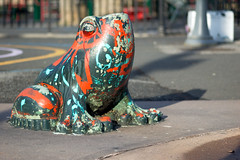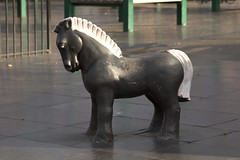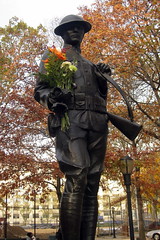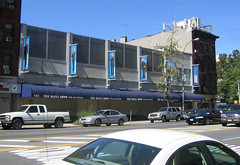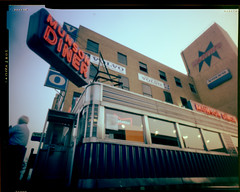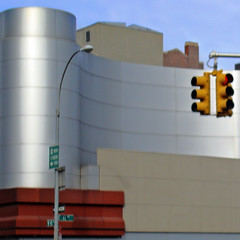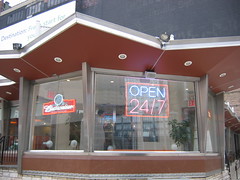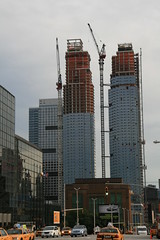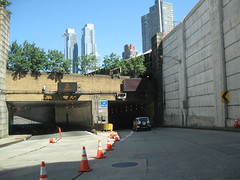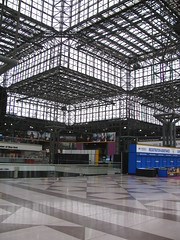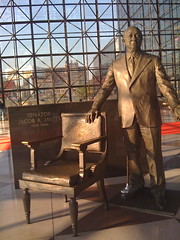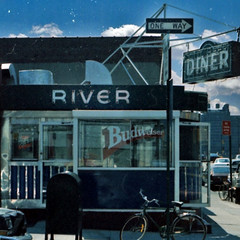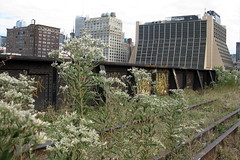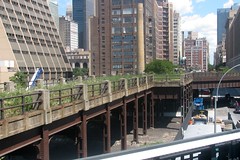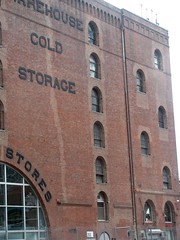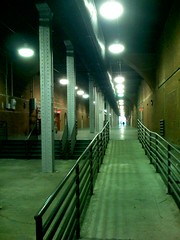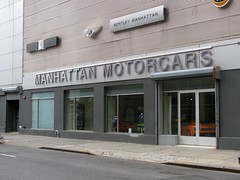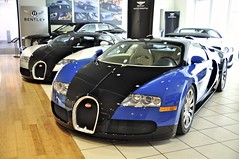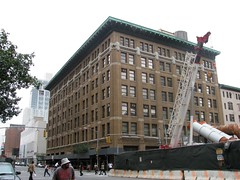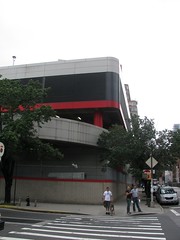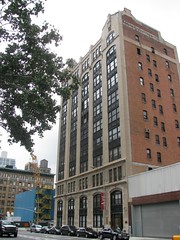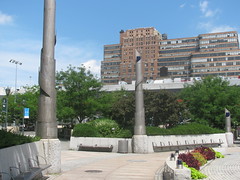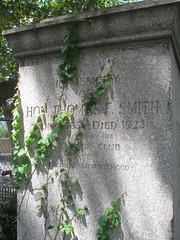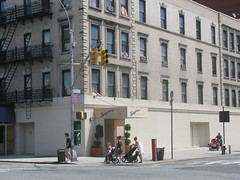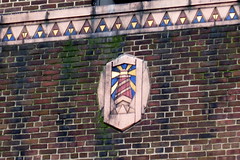|
|
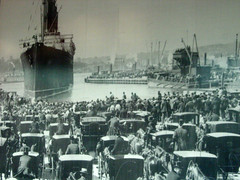
Back when Manhattan was one of the country's major
seaports, the Hudson waterfront was bustling with shipping,
transoceanic travel and ferries taking residents to and
from the
mainland. As New York deindustrialized, jets replaced
ocean liners and the island was linked with bridges and tunnels,
the waterfront became a sleepy, rather shabby zone with a
forgotten feeling.

Starting in 1998, the city decided to stop
turning its back on the sea and this project, stretching from 59th
Street to Battery Park City, was begun. The first segment opened in
2003.
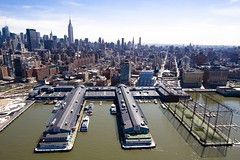
A waterfront complex designed by Warren & Wetmore and opened in 1910, these piers were a major hub for both freight and passenger liners; many immigrants actually docked here first before being taken by ferry to Ellis Island. Troops departed from here to the European front in both world wars.
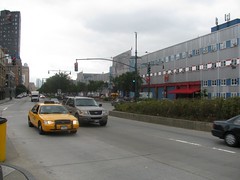
As passengers took to the air and freight traffic shifted to New Jersey, the Chelsea Piers declined, until by the 1980s they were
almost demolished for the West Side Highway project. When that fell through, the piers were turned over to a private entity, Chelsea Piers Management, for development into a sports complex--which opened in stages starting in 1995.
Pier 62
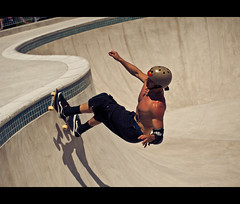
The northern most pier of the sports complex is mainly devoted to a roller rink, featuring launchboxes, spines, quarterpipes, mini ramps, flat rails, a vert ramp and a funbox. If you know what all those are, this is the place for you. For everyone else, there's also a little park at the end of the pier. During the piers' lost years, a U.S. Customs Impound Station was located here.
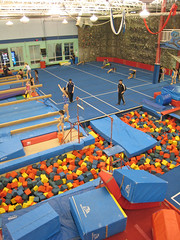
The Field House between piers 62 and 61 houses gymnastics, rock climbing, soccer, basketball and baseball programs.
Pier 61
Features the Sky Rink, an ice rink so-called because it was formerly located atop the Westyard Distribution Center at 10th Avenue and 31st Street. Features hockey, figure skating and general skating.
Silver Screen Studios, located here, was used to shoot such films as You've Got Mail, Big Night and Everyone Says I Love You, as well as TV shows like Law and Order, Special Victims Unit and Spin City.
Pier 60
Jesse Owens sailed from this pier in 1936 aboard the S.S. Manhattan to take part in the Berlin Olympics. Now houses the Sports Center at Chelsea Piers, featuring swimming, running, cycling, rock climbing, basketball, sand volleyball, boxing, weight lifting, yoga, pilates and more. Also the Pier 60 event space.
300 New York, Chelsea Piers' bowling alley and
video arcade, is located between piers 60 and 59.
Pier 59
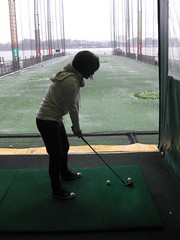
Houses Chelsea Piers' Golf Club. The Ice Theatre of New York is also based here.
Pier 57
Built in 1957 and designed by Emil Praeger using "floating pier" technology he developed during World War II. The pier rests on three buoyant concrete boxes built in Haverstraw, N.Y., and towed down the river into place. In 2011, the Hudson River Park Trust was looking for a private entity to develop the site.
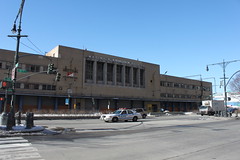
Pier 54
Semicircular metal
structure on the riverfront marks the Cunard Piers, where the Titanic was supposed to dock on April 17,
1912; instead, the Carpathia arrived here on April 18 with 705 survivors of the disaster. Another doomed
ship, the Lusitania, sailed from here on May 1, 1915. Today the pier is used for events like the park's RiverFlicks and RiverRocks series.
The first ship to travel through the Erie Canal,
the Seneca Chief, docked here November 4, 1825 after a nine-day trip from Buffalo. It was piloted by Gov. DeWitt Clinton, the politician most responsible for the construction of the engineering marvel.
Gansevoort Peninsula
Landfill used by Sanitation Department, salt storage,
FDNY Marine Company No. 1. Contains a remnant of New York's lost 13th Avenue, which was removed
to allow longer ships to dock at New York piers.
Pier 51
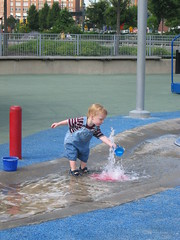
A neat little play-ground with lots of water features, including a stream running through it based on Greenwich Village's lost Minetta Brook. The jungle gym is meant to evoke the White Fort, the War of 1812-era fortification that gave Gansevoort Street its (translated into Dutch) name.
AIDS Memorial
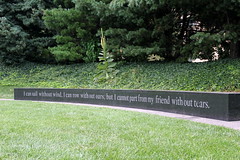
A 42-foot-long
curved stone bench serves as New York City's permanent memorial to those lost to AIDS, looking out over the pilings of the former Pier 49. Dedicated in 2008.
Pier 46
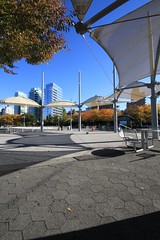
Features a synthetic turf lawn for active recreation. The piles of the missing outer half of the pier have been left as a fish habitat.
From this shore on August 17, 1807 Robert Fulton launched the first commercially viable
steamship, the North River, later renamed the Clermont.
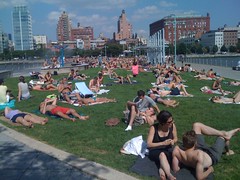 The Christopher Street
Pier, an 850-foot structure with wood decking and grass lawns, has been a longtime source of
controversy because of its use by transexual sex
workers and the homeless, and more recently by gay youth of color. Note bow notch to its north, cut to allow
ships to dock here that were too long for the pier.
The Christopher Street
Pier, an 850-foot structure with wood decking and grass lawns, has been a longtime source of
controversy because of its use by transexual sex
workers and the homeless, and more recently by gay youth of color. Note bow notch to its north, cut to allow
ships to dock here that were too long for the pier.
Pier 40
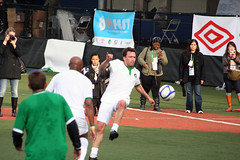
At 14 acres, this is the largest of the Hudson River Park's piers, much of which is dedicated to sports fields. It's the starting point for boat excursions and a Greenwich Village walking tour, and houses the offices of the Hudson River Park Trust. The pier was built in the early 1960s for Holland America Cruises, just as intercontinental jet travel was killing off the trans-Atlantic cruise line business.
Pier 34

Consists of two slender walkways that provide access to the Holland Tunnel ventilation shaft emerging from the Hudson; the southern walkway is open to the public.
Pier 26
Downtown Boathouse
Pier 25
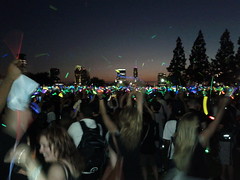
Features a skate park and a miniature golf course.
|
|
1
1
T
H
A
V
E
N
U
E
1
1
T
H
A
V
E
N
U
E
1
1
T
H
A
V
E
N
U
E
1
1
T
H
A
V
E
N
U
E
1
1
T
H
A
V
E
N
U
E
1
1
T
H
A
V
E
N
U
E
W
E
S
T
S
T
R
E
E
T
W
E
S
T
S
T
R
E
E
T
W
E
S
T
S
T
R
E
E
T
W
E
S
T
S
T
R
E
E
T
W
E
S
T
S
T
R
E
E
T
W
E
S
T
S
T
R
E
E
T
W
E
S
T
S
T
R
E
E
T
W
E
S
T
S
T
R
E
E
T
W
E
S
T
S
T
R
E
E
T
W
E
S
T
S
T
R
E
E
T
W
E
S
T
S
T
R
E
E
T
W
E
S
T
S
T
R
E
E
T
W
E
S
T
S
T
R
E
E
T
|
|
East:
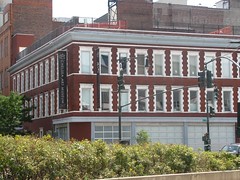
Corner (556 W 22nd): An institution that features the work of artist Jean Miotte and kindred spirits.
154: The site of Longshoremen's Rest,
set up by the Church Temperance Society in 1910
to provide alternatives to drinking.
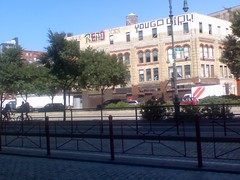
142 (corner): Was the Eagle's Nest, gay bar
where part of the homo- phobic film Cruising
was shot with Al Pacino.
|
|
|
East:
120 (corner): This red-brick building
was a factory making Life Savers starting
in 1913; the candy had been invented the year
before, and named in the wake of the Titanic disaster. Was The Spike,
the largest leather bar of the pre-AIDS era. Now converted into luxury condos known as the
Lifesaver Lofts.
|
|
|
East:
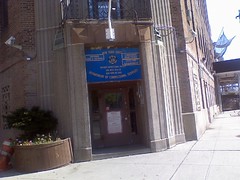
Corner (550 W 20th): A medium-security women's
prison. Built in 1931 as the Seamen's House
YMCA; converted to drug rehab center in 1967,
and to a prison in 1974. The south wall
features a red-and-pink abstract mural
called
Venus, painted in 1970 by
Knox Martin--now mostly eclipsed by the condo next door.
The inmates were evacuated during Superstorm Sandy and the
prison has been empty ever since.
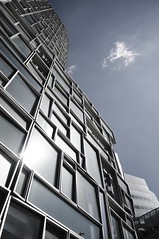
100 (corner): A luxury condo development known as Vision Machine, by architect
Jean Nouvel--noted for its crazy-quilt rectilinear facade and its six-story vertical garden.
|
|
|
East:
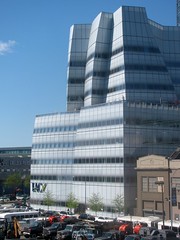
Block (555 W 18th): Star architect Frank
Gehry's first major New York City building serves as the headquarters
of Barry Diller's InterActive Corp.
|
|
|
|
|
|
|
|
|
|
|
|
East:
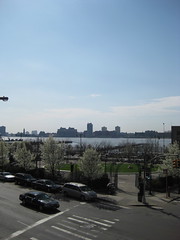 A three-quarter-acre park maintained by the Hudson River Park Trust and the Chelsea Improvement
Company, much of which is a grassy oval. Also known as 14th Street Park.
A three-quarter-acre park maintained by the Hudson River Park Trust and the Chelsea Improvement
Company, much of which is a grassy oval. Also known as 14th Street Park.
|
|
W 14TH ST ===> E
At 14th Street, West becomes 11th Avenue.
|
East:
Liberty Inn
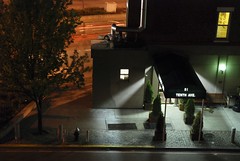
500 (block): A short-stay hotel. Used to be the Strand Hotel,
a sailors' haunt built in 1908 by the Conron Brothers poultry
dealers. In 1912, it served as the New York Times'
headquarters for covering the Titanic disaster. Later (1974-86)
The Anvil, a decadent gay club
frequented by German director Werner Rainer Fassbinder. Felipe Rose was discovered
dancing here in an Indian costume, inspiring and
becoming the first member of the Village People.
|
|
|
East:
Point (40 10th Ave): This was the divey gay dance club Alex in Wonderland.
|
|
|
East:

Corner (848 W 13th): A 20-story
boutique hotel built in 2006 to straddle the High Line, then in the process of being transformed into a park. The hotel drew some
controversy when it was discovered to be a great place to be an exhibitionist.
|
|
LITTLE W 12TH ST ===> E
|
East:
Block: Gansevoort Meat Market
|
|
GANSEVOORT ST ===> E
|
East:
Block: West Coast Apartments
|
|
|
East:
507: When novelist Herman Melville was a customs agent from 1866 until 1885, inspecting goods coming into the
Gansevoort Street wharves, he worked out of this address.
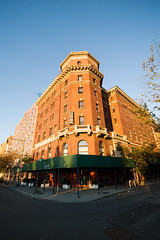
Corner (113 Jane): This 1908 building, designed by
Ellis Island's William A. Boring with a distinctive
octagonal tower on the corner, was originally the American
Seamen's Friend Society Institute, intended as a berth
"for seamen of all ranks and all nationalities visiting
the Port of New York" and "a temporary refuge for
'seamen in distress.'" Accordingly, surviving crew
members from the Titanic were taken here in
1912. It became a YMCA in 1944, and later a hotel known variously as the Jane West,
the Hotel Riverview and, starting in 2008,
The Jane.
Also houses the Jane Street Theatre, formerly the
hotel ballroom.
|
|
|
East:
493: The site of 12 West,
popular 1970s gay disco. Later the RiverClub. The building now on the site was designed to look like a
converted warehouse.
|
|
|
East:
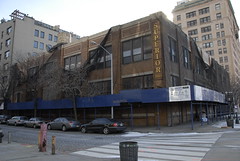
Block (400 W 12th): The Town- houses at Superior Ink,
a 17-floor 2009 condo building designed by Robert A.M. Stern. In 2013, it was the fifth most
expensive residential building by square footage in New York City--and the only one in the top 10
below 14th Street. Mark Jacobs is one owner
The name derives from the Superior Ink Building, an industrial structure originally built
as a Nabisco
cracker factory in 1919--part of the same
complex, designed by A.G. Zimmermann, as
the Oreo factory on 16th Street that is
now Chelsea Market. Despite its significance
in the history of industrial architecture,
the building was demolished in 2006.
|
|
|
East:
Westbeth
Once the Bell Telephone/ Western Electric Labor- atories, this full-block complex created or helped to
develop some of the most important inventions of the 20th Century: the vacuum tube (1912), radar (1919),
sound movies (1923) and the digital computer (1937). One of the first demonstrations of television
transmission
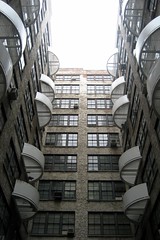 occurred here, April 27, 1927. Westbeth was also the original home of the
NBC radio network.
occurred here, April 27, 1927. Westbeth was also the original home of the
NBC radio network.
The complex was converted to an artists' colony in 1969; photographer Diane
Arbus committed suicide here, July 28, 1971. Actor Vin Diesel grew up here.
|
|
|
East:
Corner (166 Bank): Singer Grace Jones has lived here.
|
|
|
East:
425: The Rusty Knot, good bar for sunset-watching -- used to be known as West.
Perry Street Towers
Corner (173 Perry): This and the other glass
building across the street were designed by modernist
Richard Meier in 2003.
Celebrities like Nicole
Kidman, Martha Stewart and Calvin Klein have bought
apartments here, but the project was marred by
shoddy construction.
|
|
|
East:

Corner (176 Perry): The other Perry Street Tower.
Hugh Jackman has owned a unit here. There's a restaurant called Perry Street here, part of
the Jean-Georges food empire.
Corner (165 Charles): Another Richard Meier
building went up in 2005. Burned by cost-cutting on
the Perry Street Towers, Meier got the developer to
agree to self-finance most of this development in order to give the architect a large degree of control
over the construction.
|
|
|
East:
404 (corner):
T.R.E.C.; photography and lighting rental
Site of Newgate State Prison
Block: At the foot of 10th Street (then Amos Street)
was Newgate State Prison, opened in 1797 as
New York's first prison and the second prison
in the country. Despite some progressive
policies--the co-ed convicts were taught
trades, a physician and a pharmacist were
hired, and the first warden lived in
the prison along with his family--the institution
was plagued by overcrowding, riots and smallpox epidemics.
It was closed in 1829 when its inmates were
sent "up the river" to the newly opened
Sing Sing. In its day, the prison was
apparently a tourist attraction; it's
memorialized in a mosaic in the Christopher
Street subway stop.
396 (corner): Antica Venezia, Italian, was Uguale, Italian-French. Once upon a time
was Peter Rabbit's,
bar catering to young gay black men.
|
|
|
East:
394: Was
The Ramrod, gay leather bar. In 1980, a former transit cop
shot into the bar with a semi-automatic weapon, killing two and injuring six.
He was found not guilty by reason of insanity.
392: Sneakers, non-leather gay bar,
distinguished by shoes hanging from ceiling, is in a building that dates to c. 1790--
perhaps the oldest in the Village.
390: Underground Erotic Emporium
|
|
CHRISTOPHER ST ===> E
|
East:
388: Badlands, leather bar featured in the movie Cruising
384 (corner): Was
Keller's, perhaps New York's first leather
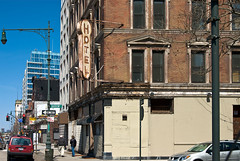 bar--dating to the 1950s. It's also been credited as the birthplace of disco;
the Village People were photographed here for an album cover.
Closed in 1998. Originally the Keller Hotel, built in 1898.
bar--dating to the 1950s. It's also been credited as the birthplace of disco;
the Village People were photographed here for an album cover.
Closed in 1998. Originally the Keller Hotel, built in 1898.
|
|
|
East:
Corner (121 Morton): This apartment building replaced the Brooks Transportation Co.,
at 375 West. Bob Dylan was
photographed in front of this building for his Blonde
on Blonde album.
|
|
|
East:
Block:
1 Morton Square; this glassy 2002 midrise has been home to Mary Kate and Ashley Olsen,
Daniel Radcliffe and Amy Poehler.
|
|
|
East:
357 (corner): Lunchbox Food Company,
stylish diner
354 (corner): West World Video, porn store named for a science fiction movie featuring Yul Brynner as a killer robot cowboy. Now gets second billing to another adult business in the same building, the West Side Gentlemen's Club.
|
|
|
East:
305 (block): This 1933 building, with almost a million
square feet of space, stretches for several blocks along West Street.
|
|
There's an underpass here allowing Houston to travel through 305 West to connect to the waterfront.
|
|
|
|
East:
Block (553 Canal): This two-story building dates to 1920.
|
|
|
|
|
|
East:
288: An 1856 red-brick loft building, once used as a spice warehouse, now luxury condos known as the Medium Lipstick Building. Jennifer Connelly and Paul Bettany bought the penthouse here for
$6 million.
|
|
|
East:
Block (34 Desbrosses): A 15-story luxury apartment building built in 2009 with the unlikely name of
Truffles Tribeca.
|
|
DESBROSSES ST ===> E
|
East:
Corner (39 Desbrosses): Ponte's Restaurant, since 1967 the home of the "angry lobster"
|
|
VESTRY ST ===> E
|
East:
Corner (67 Vestry):
|
|
LAIGHT ST ===> E
|
|
|
HUBERT ST ===> E
|
East:
Shearson Lehman Plaza
|
|
N MOORE ST ===> E
|
|
|
HARRISON ST ===> E
|
|
|
|
West:
Stuyvesant High School

This is the most prestigious public high school in Manhattan--
and maybe in the country. Founded in 1904 as a vocational school
for boys, it moved to 15th Street in
1907, where it remained for 89 years. It began admitting
female students in 1969. It moved to this new 10-story facility
in 1992.

Its students have included four Nobel
laureates; writers like Lewis Mumford, Richard H. Price and
Hubert Selby; musicians like Thelonious Monk and Steely Dan's Walter
Becker; actors including James Cagney, George Raft, Tim Robbins and
Lucy Liu, along with classic filmmaker Joseph L. Mankiewicz.
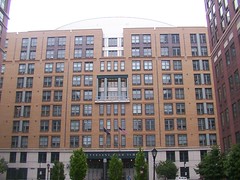
The political figures who come out of Stuy are a surpris-ingly
right-leaning lot, including Dick Morris, Roy Innis, Thomas Sowell,
Samuel P. Huntington, Ron Silver and Albert Shanker--though
Obama adviser David Axelrod and Manhattan Rep. Jerry Nadler are
graduates too.
The school was the setting of the teen cyberthriller Hackers,
as well as the student politics documentary Frontrunners.
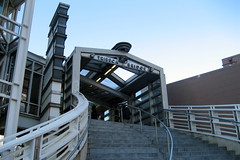
The Tribeca Bridge was built in 1992 to allow Stuy-vesant
students to cross over busy West Street.
|
|
|
East:

199 (corner): A business-oriented college
that opened in Midtown in 1964. It moved to
this facility in 1983; the campus has been
compared in size to the Empire State Building
lying on its side. Almost 20,000 students are pursuing degrees here,
while 10,000 more are in continuing education programs.
Affiliated with the campus is the
Tribeca Performing Arts Center,
established in 1983 and formerly known as
The Triplex.
Washington Market Park
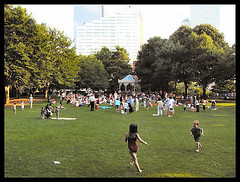
This green space, commem-orating what
was once New York's main produce market
(now relocated to Hunts Point), is ''one of the city's
best small parks''--AIA Guide.
|
|
West:
Tribeca Bridge Tower is a 26-story
apartment tower that rises above
PS/IS 89, completed in 1998.
|
|
|
East:

170 (corner): P.S. 234, a creative school design
by Richard Dattner, completed 1988. The kids
here had to flee the September 11 attacks up
the West Side Highway; there was much concern
among parents that the school was reopened
before it was fully decontaminated.
|
|
West:
Battery Park City Ballfields
|
|
|
|
West:
Goldman Sachs Headquarters
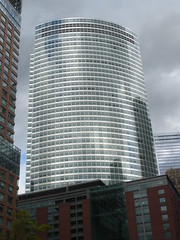
200 (block): Forty-three stories built from 2005-09, designed by Pei Cobb Freed, with a parabolic eastern facade and a
deconstructivist western face. The company built at about the same time another similarly sized office tower across the Hudson in Jersey City. Founded in 1869 by Marcus Goldman and (later) his son-in-law Samuel Sachs, it's probably the most politically connected
corporation in the world -- having produced three U.S. Treasury
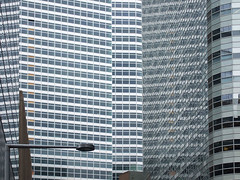 secretaries, a White House chief of staff, a New York Fed chief, an Italian prime minister, a New Jersey governor.... The list goes on.
secretaries, a White House chief of staff, a New York Fed chief, an Italian prime minister, a New Jersey governor.... The list goes on.
|
|
|
East:
Block (125 Barclay): This 10-story building from 1932 is the headquarters of District Council 37, the powerful coordinating body for the area's AFSCME unions, and many of its affiliated locals.
|
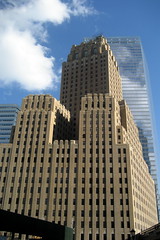
140 (block): Built from 1923-27 for New York Telephone, this 32-story brick-and-limestone structure designed by Ralph Walker is considered the first Art Deco skyscraper. Noted for its dramatic setbacks, its communication-themed murals and its Guastavino-vaulted
pedestrian arcades. It was seriously damaged during the September 11 attacks but survived thanks to its solid masonry construction. It now serves as the headquarters of Verizon Communications.
|
|
West:
World Financial Center
A group of office buildings designed by Cesar Pelli and built in 1985-88 on landfill from the construction of the original World Trade Center.
3 World Financial Center
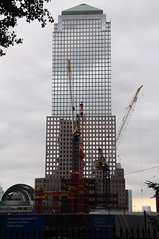
Corner (200 Vesey): At 51 stories, this 1986 post-modern skyscraper is the tallest building in the World Financial Center. It's distinguished by the pyramid on its roof. It serves as the world headquarters of the American Express corporation, which owns the building. Other tenants include the Security & Exchange Commission and the Royal Bank of Canada.
Winter Garden
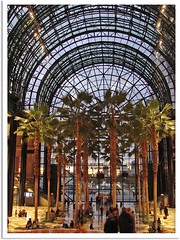
A glass-vaulted atrium connecting World Financial Center's Nos. 2 and 3, it was first opened in 1988 and basically destroyed during the September 11 attacks in 2001. It was reopened in September 2002 after 2,000 panes of glass, 60,000 square feet of marble and 16 40-foot palm trees were replaced--the first major structure to be rebuilt after the disaster.
2 World Financial Center
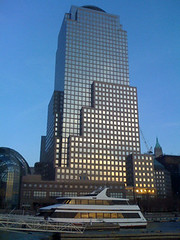
Corner (225 Liberty): This 1987 building is 57 stories crowned with a dome. It houses the Merrill Lynch World Headquarters, as well as offices of Commerzbank, Deloitte & Touche and France Telecom.
|
|
|
East:
Ground Zero
Freedom Tower
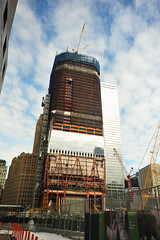
The single tower that is replacing the Twin Towers as the high point of the World Trade Center will have 104 stories, six fewer than the previous buildings, but will match the height of the taller of the twins, at 1,368 feet. (Counting its antenna, it will a symbolic 1,776 feet--though the connection between post-terrorism rebuilding and independence from Britain is somewhat murky.) When completed, it will be New York's and the U.S.'s tallest building, and the third tallest building in the world.
The start of construction was delayed until 2006, largely due to squabbling between the state government and developer Larry Silverstein.
The project's popular name was given it by then-Gov. George Pataki, though the Port Authority prefers that it be referred to as One World Trade Center, and insists this has nothing to do with the fact that the first major tenant is the China Center.
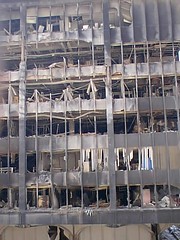
Completed in 1975, this eight-story building housed the U.S. Customs House and other government offices, including the Export-Import Bank of the United States and the Peace Corps' regional office. It was destroyed on September 11, 2001, by debris from the North Tower and subsequent fire.
Site of North Tower
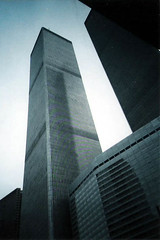
The WTC towers were not exactly twins; both were 110 stories, but the North Tower was slightly taller, at 1,368 feet, making it (briefly) the tallest building in the world. (With its TV antenna, it was 1,728 feet.) Construction lasted from 1966-73; the towers opened in 1975. Windows on the World, located here, was the world's highest restaurant.
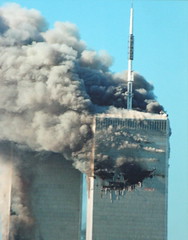
It was hit by American Airlines Flight 11 at 8:46 a.m. and collapsed at 10:28--the first tower to be hit but the second to collapse. One thousand, four hundred and two workers died in the attack, including 658 Cantor Fitzgerald employees. Including the
passengers on the plane and the rescue workers, the majority of those killed on September 11 died at this address.
The site of the towers became reflecting pools as part of the September 11 memorial.
Site of 3 WTC
Corner: This was the address of the Marriott World Trade Center, destroyed in the September 11 attacks. Opened in 1981 as the Vista Hotel, it took heavy damage in the 1993 attempt to bring down the World Trade towers. It was sold to Marriott in 1995.
|
|
